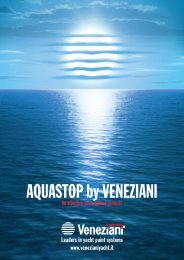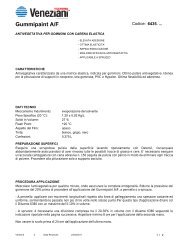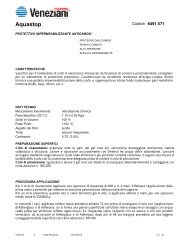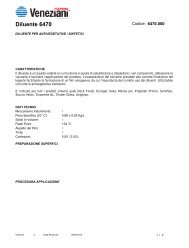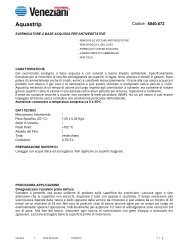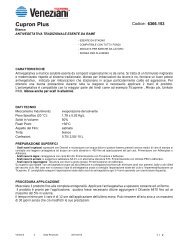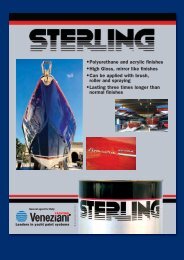3 - Veneziani Yacht Paints
3 - Veneziani Yacht Paints
3 - Veneziani Yacht Paints
Create successful ePaper yourself
Turn your PDF publications into a flip-book with our unique Google optimized e-Paper software.
3 PAINTING YOUR BOAT<br />
ANTIFOULING PROTECTION OF SPECIAL PARTS<br />
METAL KEELS, FLAPS AND RUDDERS<br />
Flaps and rudders made of steel or<br />
alloys and other metal parts below<br />
the waterline are areas of high<br />
abrasion and wear.<br />
You must carefully prepare the surfaces<br />
(lead, cast iron or stainless<br />
steel) to be painted using an abrasive<br />
disc or by grit blasting to remove<br />
all traces of old paint and<br />
rust.<br />
We recommend that you use the<br />
two-pack system based on EPOXY<br />
PRIMER (1 coat with a brush) and<br />
AQUASTOP (3 coats with a short<br />
pile roller) to attain a thickness of<br />
600 microns. After the last coat<br />
has been applied you must wait at<br />
least 48-72 hours before continuing<br />
the paint system with a coat<br />
of ADHERGLASS or ADHERPOX<br />
and then the antifouling as on the<br />
rest of the hull.<br />
Where necessary fill the keel<br />
using EPOMAST PRO (on top of<br />
EPOXY PRIMER). Then sand<br />
and apply AQUASTOP.<br />
30<br />
STERN DRIVES<br />
All boat motors are primed and stove-enamelled<br />
by the manufacturer.<br />
However they must also be treated<br />
with a special antifouling product<br />
to protect them against fouling.<br />
If the stern-drive is in good condition,<br />
wash the immersed part thoroughly<br />
with DETERSIL and, after<br />
sanding with fine abrasive paper,<br />
apply:<br />
• 1 coat of PROPELLER PRIMER<br />
(with a brush)<br />
• 2 coats of PROPELLER antifouling.<br />
On the parts above the water:<br />
• 2 coats of GEL GLOSS PRO finish.<br />
If the stern-drive is in a poor condition,<br />
you must strip it to the bare<br />
metal by sanding or, where possible,<br />
using an abrasive disc. Then it<br />
should be protected using EPOXY<br />
PRIMER (1 coat with a brush) and<br />
AQUASTOP (3 coats with a short<br />
pile roller or a brush).<br />
Finish the system as for the submerged<br />
parts.<br />
PROPELLERS (bronze)<br />
AND SHAFTS (stainless steel)<br />
When treating propellers you must<br />
be scrupulous, even fanatical,<br />
about their cleaning and preparation.<br />
If you apply a system which is<br />
too thick, the profile, and therefore<br />
the action, of the propeller will be<br />
altered. Special products have<br />
been developed which can be applied<br />
in thinner layers and which<br />
have high adhesion characteristics.<br />
The entire system must be<br />
renewed every season.<br />
Follow the steps below:<br />
• sand with coarse grade sandpaper,<br />
scoring the surface;<br />
• degrease with DETERSIL or<br />
another degreasing detergent.<br />
Repeat several times using a clean<br />
sponge and rinsing with fresh water.<br />
Do not use solvents which will not<br />
eliminate the grease but simply<br />
spread it around the surface. Be<br />
careful not to smear the clean surface<br />
or touch it with rags or fingers.<br />
Any remaining traces of grease can<br />
affect the adhesion of the product.<br />
• Apply 1 coat of PROPELLER PRI-<br />
MER and after 6-12 hours apply 2<br />
coats of PROPELLER antifouling,<br />
leaving 12 hours between each<br />
coat. PROPELLER antifouling<br />
The information given is a summary of the technical data sheets, for more details please contact the MTD.<br />
PROPELLER<br />
Antifouling for propellers, shafts<br />
and stern-drives<br />
CHARACTERISTICS<br />
Antifouling formulated specifically<br />
for the protection of<br />
propellers, shafts, stern-drives,<br />
flaps, etc. where highest<br />
adhesion and abrasion<br />
resistance is required. This<br />
antifouling is copper and tin<br />
free and therefore suitable<br />
for all types of metal, providing<br />
excellent adhesion and<br />
good antifouling protection.<br />
Must be used in combination<br />
with Propeller Primer in<br />
order to perform properly.<br />
The new formulation has improved<br />
resistance against<br />
cathodic overprotection.<br />
TECHNICAL DATA<br />
Specific weight:<br />
1,30 +/- 0,02 Kg/L<br />
Solids by volume: 45%<br />
Colour:<br />
white, Volvo grey, black<br />
Packaging: 0,25 L<br />
should only be applied on top of<br />
PROPELLER PRIMER or on top of<br />
a sanded layer of antifouling. Wait<br />
at least 48 hours before launching.<br />
Note: some alloys used for propellers<br />
cannot be painted, due to<br />
adhesion problems.<br />
Do the PROPELLER first<br />
When you are “doing” the hull,<br />
paint the propeller first, not last.<br />
This gives the PROPELLER hard<br />
antifouling more time to dry completely.<br />
APPLICATION DATA<br />
Apply with: brush<br />
Drying time before use<br />
(20°C): 48 hours<br />
Thinner:<br />
6470 for cleaning only<br />
DFT per coat: 30 µ<br />
Theoretical coverage per<br />
coat: 15,0 m 2 /L<br />
Recoating time (20°C):<br />
min 6 hours/max 24 hours<br />
Number of coats: 2



